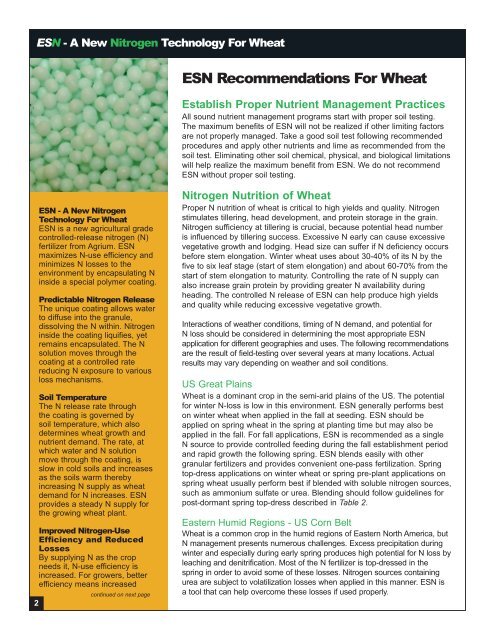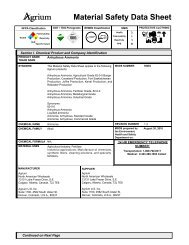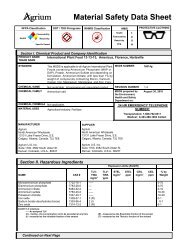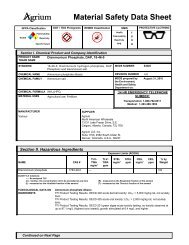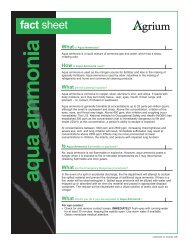ESN Wheat Fact Sheet 0408.qxp - Agrium Wholesale
ESN Wheat Fact Sheet 0408.qxp - Agrium Wholesale
ESN Wheat Fact Sheet 0408.qxp - Agrium Wholesale
Create successful ePaper yourself
Turn your PDF publications into a flip-book with our unique Google optimized e-Paper software.
<strong>ESN</strong> - A New Nitrogen Technology For <strong>Wheat</strong><br />
<strong>ESN</strong> Recommendations For <strong>Wheat</strong><br />
Establish Proper Nutrient Management Practices<br />
All sound nutrient management programs start with proper soil testing.<br />
The maximum benefits of <strong>ESN</strong> will not be realized if other limiting factors<br />
are not properly managed. Take a good soil test following recommended<br />
procedures and apply other nutrients and lime as recommended from the<br />
soil test. Eliminating other soil chemical, physical, and biological limitations<br />
will help realize the maximum benefit from <strong>ESN</strong>. We do not recommend<br />
<strong>ESN</strong> without proper soil testing.<br />
2<br />
<strong>ESN</strong> - A New Nitrogen<br />
Technology For <strong>Wheat</strong><br />
<strong>ESN</strong> is a new agricultural grade<br />
controlled-release nitrogen (N)<br />
fertilizer from <strong>Agrium</strong>. <strong>ESN</strong><br />
maximizes N-use efficiency and<br />
minimizes N losses to the<br />
environment by encapsulating N<br />
inside a special polymer coating.<br />
Predictable Nitrogen Release<br />
The unique coating allows water<br />
to diffuse into the granule,<br />
dissolving the N within. Nitrogen<br />
inside the coating liquifies, yet<br />
remains encapsulated. The N<br />
solution moves through the<br />
coating at a controlled rate<br />
reducing N exposure to various<br />
loss mechanisms.<br />
Soil Temperature<br />
The N release rate through<br />
the coating is governed by<br />
soil temperature, which also<br />
determines wheat growth and<br />
nutrient demand. The rate, at<br />
which water and N solution<br />
move through the coating, is<br />
slow in cold soils and increases<br />
as the soils warm thereby<br />
increasing N supply as wheat<br />
demand for N increases. <strong>ESN</strong><br />
provides a steady N supply for<br />
the growing wheat plant.<br />
Improved Nitrogen-Use<br />
Efficiency and Reduced<br />
Losses<br />
By supplying N as the crop<br />
needs it, N-use efficiency is<br />
increased. For growers, better<br />
efficiency means increased<br />
continued on next page<br />
Nitrogen Nutrition of <strong>Wheat</strong><br />
Proper N nutrition of wheat is critical to high yields and quality. Nitrogen<br />
stimulates tillering, head development, and protein storage in the grain.<br />
Nitrogen sufficiency at tillering is crucial, because potential head number<br />
is influenced by tillering success. Excessive N early can cause excessive<br />
vegetative growth and lodging. Head size can suffer if N deficiency occurs<br />
before stem elongation. Winter wheat uses about 30-40% of its N by the<br />
five to six leaf stage (start of stem elongation) and about 60-70% from the<br />
start of stem elongation to maturity. Controlling the rate of N supply can<br />
also increase grain protein by providing greater N availability during<br />
heading. The controlled N release of <strong>ESN</strong> can help produce high yields<br />
and quality while reducing excessive vegetative growth.<br />
Interactions of weather conditions, timing of N demand, and potential for<br />
N loss should be considered in determining the most appropriate <strong>ESN</strong><br />
application for different geographies and uses. The following recommendations<br />
are the result of field-testing over several years at many locations. Actual<br />
results may vary depending on weather and soil conditions.<br />
US Great Plains<br />
<strong>Wheat</strong> is a dominant crop in the semi-arid plains of the US. The potential<br />
for winter N-loss is low in this environment. <strong>ESN</strong> generally performs best<br />
on winter wheat when applied in the fall at seeding. <strong>ESN</strong> should be<br />
applied on spring wheat in the spring at planting time but may also be<br />
applied in the fall. For fall applications, <strong>ESN</strong> is recommended as a single<br />
N source to provide controlled feeding during the fall establishment period<br />
and rapid growth the following spring. <strong>ESN</strong> blends easily with other<br />
granular fertilizers and provides convenient one-pass fertilization. Spring<br />
top-dress applications on winter wheat or spring pre-plant applications on<br />
spring wheat usually perform best if blended with soluble nitrogen sources,<br />
such as ammonium sulfate or urea. Blending should follow guidelines for<br />
post-dormant spring top-dress described in Table 2.<br />
Eastern Humid Regions - US Corn Belt<br />
<strong>Wheat</strong> is a common crop in the humid regions of Eastern North America, but<br />
N management presents numerous challenges. Excess precipitation during<br />
winter and especially during early spring produces high potential for N loss by<br />
leaching and denitrification. Most of the N fertilizer is top-dressed in the<br />
spring in order to avoid some of these losses. Nitrogen sources containing<br />
urea are subject to volatilization losses when applied in this manner. <strong>ESN</strong> is<br />
a tool that can help overcome these losses if used properly.


